Text and Logo ::pe PR::
The Text and Logo library by Phalkanubba Rath contains "text" type emitters that are
intended to be used with text or logo images. The text emitters use images (bitmaps,
sprites, etc.) for the text, just like any other emitter, so to change the text,
just create a text image in your favorite paint application and import into particleIllusion.
There are 3 basic text images that these emitters use (although there are some subtle
variations as I'll mention shortly): "solid text", "outlined text", and "outlined
with a shaded fill". These are simple to create in almost any paint app, just remember that
you need to make the image sizes powers of 8: 64, 128, 256, 512, 1024. The shapes in this
library are 1024 x 256, but that may be larger than required: 512 x 128 would probably
work just as well (plus would use less memory and have better performance).
The variations that I mentioned above are mainly combinations of blurring, erasing portions
of the "outlined" text, or creating text with a "beveled" or "3D" look. Blurring and
erasing are easy to do in most paint apps, while "3D" text is more advanced.
In most cases you'll want to create the text as white (or grey) text on black then import
it into pIllusion as "greyscale" not "full-color". Only import as "full-color" if you want
the text to retain some of its original coloring AND the particle type is not set to
"intense". (If the particle type is "intense", it's being converted internally into
greyscale anyway.)
Finally, these emitters are organized here into 3 main groups based on the length of
time they take to "settle down" and show the text clearly. There may be some
emitters that are in one group and you think they should be in another -- feel free to move
them around.
Long Spin Cycle
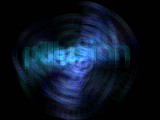
Spinning and rotating text finally comes into "focus" after about 200 frames.
To make it come in sooner (frame 100 for instance), you'll need to scale 3 graphs: "x radius", "y radius", and
particle type "spin". Scale the x-values of each graph by tha same amount (50% in this case). Note that this
may change the way the particles move.
The "secret" to these text emitters that appear to "orbit" (move in a circular motion) is that they are circle or
ellipse emitters, and use the "emit at points" value (usually set to "360") to make the particles progress around
the circle - a nice trick.
Long Converge Straight
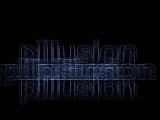
The particles come in from 4 directions and "converge" to form the text after a long period (over 250 frames).
To shorten the time it takes to converge, scale the "radius" and emitter "Number" x-values, then the emitter "Life"
y-values by the same amount.
Long Slow Swirl 01
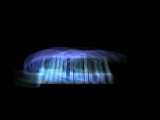
The text orbits the emitter reference point, then the text comes into focus at the bottom of the orbit path,
then a short time later again at the top of the orbit path. Very complex.
Speeding it up is a little tricky too -- let's assume you want it to be twice as fast. Scale the "X radius" x-values
by 50%, scale the emitter "Life" y-values by 50%, scale the emitter "Number" y-values by 200% (since we decreased the
particle life, we increase the number of particles to get the same particle "density"), then the tricky part:
change the "emit at points" value from 360 to 180 (a 50% scale).
Long Slow Swirl 02
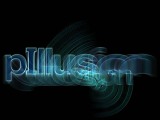
The text starts out almost in "focus", but then spins slightly and "smudges", and the text doesn't clarify until frame
400 or so. To make it happen sooner, scale the "x radius" and "y radius" x-values by
50%, then scale the emitter "Life" y-value by 50%, and increase the emitter "Number" (but scaling by 200% might be too much).
Long Wave Up Down

The text orbits in a small circle, but then forms at the top and bottom of the circle. Repeats this way
for quite a while (the text does not "settle down").
You can increase the distance between the top and bottom text by increasing the "y radius" value. You can also
try scaling up the "x radius" graph, but that just seems to spread out the text a bit more.
Long Slow Spin Fall
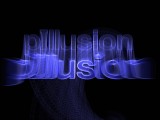
This is a nice, calm effect that has the text rotating somewhat then falling, but also has a copy of the text
rising. Stays interesting for over 1100 frames.
Can be sped up (a nice variation) by scaling "life" by 50%, then "weight" and "spin" by 200%. Perhaps may need to increase
"number" as well a bit. This is another emitter that has "keep particles in order" checked, but probably does not need
it, so uncheck (to save memory) and leave it unchecked if there is no visual difference.
Long Slow Rise
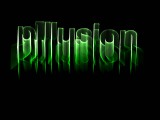
The text slowly fades in (takes 120 frames or slow) then slowly rises, with a slight "ripple" effect. The text never
fully settles in.
You can speed things up by decreasing the emitter life, but you may see unwanted colors coming in at the end of the
particle life (due to a long-standing bug in the color calculation code). If you do decrease life, you may want to
increase "weight" as well to compensate.
The "ripples" are caused by the emitter "size" graph, so you can modify it there (delete the data keys
so it doesn't ripple, modify them so it ripples less, or more smoothly, etc.).
Long Spin Wave
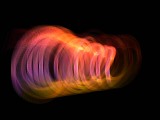
Large swooping "circle" of text, and the text doesn't start getting clear until after frame 500, but never becomes
completely clear (and then starts circling again).
To make things happen more quickly, scale the x-values (not the y-values) for "x radius" and "y radius" by 50% (or more).
Medium Grow and Pulse

A really interesting effect, with a black copy of the text over the "glowing" portion, and the text "pulses" at around
frame 100.
To make things happen more quickly, you need to scale the x-values of the "size" graph of both particle types, the x-values
of the emitter "visibility", and the x-values of the "orange" particle type "visibility".
Medium Quick Orbit Stop
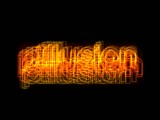
The text starts out moving outward in a circle, then at about frame 80 it settles down and it moves upward and downward only.
This is not an easy effect to speed up -- if you must do it, scale the x-values of every property in the hierarchy that
animates (has more than one data point).
Medium Rotate and Settle
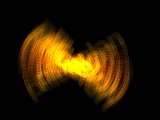
The text orbits for a brief period, rotates a little, then stabilizes and fades away.
A nice variation is to select the "radius" property, then increase the first data point from 30 to 200 or so -- this makes
the early particles "spin in" from further out, and gives the effect more motion.
Medium Grow and Slow Fall
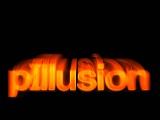
A "calm" effect where the text appears then slowly falls and fades out, with this cycle repeating several times.
If you want to change the color of this effect, at first look the particle color gradient appears to be black. Actually the first
two color points are very dark colors but not black -- change the colors of these first two points. Don't make them lighter though,
since for intense particles the brightness of the colors contribute to the visibility of the particles (which means that for "intense"
particles, the visibility of the particle is determined by 1) the emitter "visibility" property 2) the particle type "visibility"
property 3) the particle type transparency gradient 4) the particle type color gradient brightness.
Medium Quick Top Bottom
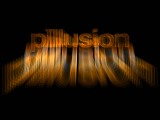
The text quickly alternates from top to bottom, leaving a trail as it moves. After some time the text settles down and stays in the
center.
The "x-radius" is set to zero (or a very small value) and the "y-radius" is what controls the distance between the top and bottom.
You can scale the "y-radius" values to increase or decrease the distance, or change the frame number at which it steps down
to zero (or a very small value) to make it settle down sooner (or later).
A nice variation is to increase the y-radius size, then adjust the emitter "angle" property to 45 degrees -- or 90 to make
the text alternate left and right instead of up and down.
Medium Grow Up
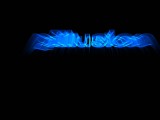
A simple "text moving up and growing" effect. Stops growing at frame 200 or so.
Change the frame number it stops growing at by changing the emitter "size" graph. You can also add some color points to the
particle gradient to add some variety.
Medium Multiple Rotate

A complex effect that starts as a blue swirl that quickly forms the text, then a counter-spinning white version of the
text is overlayed.
The most amazing thing about this effect is that it uses a single particle type for both the blue and white portions. To
change the colors, the second color point in the gradient corresponds to the blue portion of the effect, and the first
color point corresponds to the white portion. Why is it reversed this way? The "repeat" slider under the color gradient --
the gradient is being repeated a few times, which results in the apparent "reverse" of the colors (the transparency
gradient is keeping the particles non-visible when they are white the first time).
Medium Grow Flash and Shrink
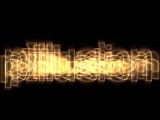
The text grows while spinning slightly (after a short delay), then flashes, pulses, and shrinks back down.
This effect completes in about 200 frames. To shorten or lengthen it, you'll need to scale the x-values of several graphs:
emitter "life", "size", "spin", "angle", and "radius"; also particle type "life", "number", "size", "spin", "visibility",
"size variation", and "spin variation". Each must be scaled by the same factor.
Medium Spin Wave
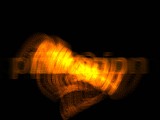
The text spins slightly as it grows, then after about 100 frames the still text appears and fades away with some copies moving
off to the sides.
To change the speed of this effect, there are again many property graphs that must be scaled (x-values). Rather than list them
all here, just go down the hierarchy list and scale any graphs that have more than one data point.
Medium Orbit Converge Electric
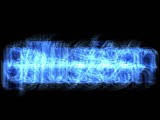
This looks a little like a combination of two other effects: the text orbits, converges, then pulses but in an "electric" way.
To make it happen faster, you can scale the x-values of the "radius" graph, as well as both particle type "visibility" graphs.
Medium Smoulder
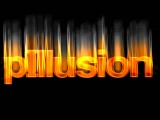
The text fades in and appears to "smoulder" in a wavy way.
Adjust the amount of waviness by scaling the y-values of the "radius" graph. The "pulses" of lighter partiles are due to
the "spinning word" particle type "visibility" graph -- you can reduce or move the data points that cause that graph to
"spike".
Medium Spin Grow Disperse
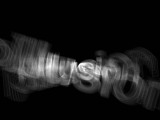
The name describes it well. Not too much rotation -- just enough to make it interesting.
Takes about 100 frames for the text to stabilize, and the text fades out at frame 220 or so. To speed this up, the x-values of
the following properties need to be scaled: emitter "angle" and "radius", and particle type "number", "size", and "spin".
A cool effect is to animate the "tint strength" so it reaches 100% at about frame 200 -- this makes the color change gradually from
white to red (or whatever tint color you choose).
Medium Swing Smear
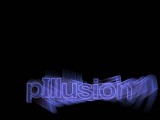
The text slowly smears in a small arcing motion, with the text coming into "focus" in front while the smearing continues
behind. A very cool effect, although it moves slowly -- the text doesn't focus until frame 140 or so.
It's fairly simple to speed things up though -- just scale the x-values of the emitter "radius" and both particle type
"spin" graphs by the same amount (50% for instance).
Medium Shrink and Rise
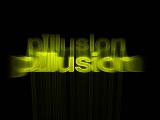
Text starts almost in focus, shrinks slightly as it falls, but then copies rise as well at some points -- always leaving a
smooth trail. The text is never really perfectly clear, although when a new copy rises or falls you can make out the text.
The particle type "weight" graph is what causes the text to rise and fall, so you can move the "peaks" in the graph, add new
peaks, smooth out the peaks, etc. to change the way it works. For instance, add a lot of "zig-zags" to this graph, and you'll
see many more copies of the text rising and falling at different times.
Medium Twist Rise
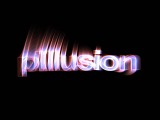
Blue with red text twists slightly, then pulses later. A nice "smeared" effect, and the red and blue combines beautifully.
The "pulsing" later in the effect is due to changes in the "x radius" value, so you can modify that graph (scale it, delete points,
add points, etc.) to change the "pulses".
This emitter looks good with the "outline text" particle type turned off too, which is a nice variation. Remember that you can
turn a particle type off by clicking its icon (the star icon) in the hierarchy.
Short Big Orbit
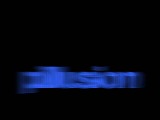
The text orbits continuously, slowing down once in a while, only completely coming into focus when it slows down.
You can make it orbit more slowly by increasing the "emit at points" value (unfortunately 1000 is the maximum value), but
you may want to decrease "number" as well (although it's pretty low already).
For a nice variation, turn off "intense", and check "keep particles in order". You may need to adjust the color and
transparency gradients.
Short Shake
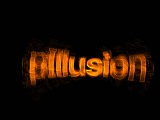
The text shakes by rotating slightly.
Difficult to modify, but changing reference point slightly may be interesting.
Short Small Orbit Blur
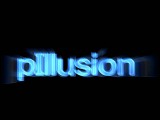
This one is subtle. The text is immediately visible, and moves in a very small circle while faint copies grow and fade to
create a blur effect.
Increasing the "radius" value increases both the size of the orbit and the amount of "blur". Since it takes a little while to
get going, you may want to set the "preload" value to 90 or so.
Short Grow and Pulse
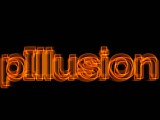
The text grows with a slight smear, then pulses once, and seems to "swing" slightly for a very long time.
This and many of these other emitters can be easily scaled in size by using the emitter "zoom" property. The interesting
thing about this emitter is that I don't understand how it works. If you look at the "black" particle type, you'll see that
its color gradient is not black at all, but the particles are completely black. So this means that if you want to modify
this emitter, you'll need to just experiment.
Short Smear and Waver
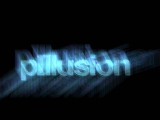
A great effect that starts with 2 very blurry "smears" that then form the text.
You can increase the amount of smear by increasing the value of the first data key in the "x radius" graph. You can change the
direction of the smear by changing the emitter "angle" value.
Short Grow and Shrink
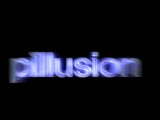
The text grows, sits there with a nice "flare" on all corners of the text, then eventually shrinks and fades away at around
frame 200.
Scale the emitter "size" and "angle" x-values to make it shrink and fade away more quickly.
Short Subtle Blur
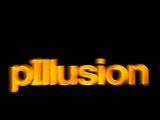
The text very slowly moves to the right, with a slight blurring effect. A simple, subtle effect.
You may want to set the preload value (in the emitter properties dialog) to 90 or so to make the text instantly visible.





























